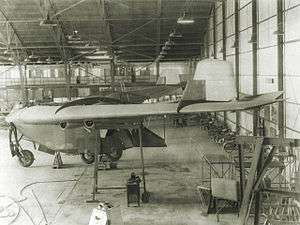DINFIA IA 38
The DINFIA IA 38 was a 1960s Argentine four-engine experimental tailless transport aircraft, designed under the direction of Reimar Horten and based on the German Horten Ho VIII project and built by the DINFIA.
| IA 38 | |
|---|---|
 | |
| The prototype IAe.38 under construction | |
| Role | Experimental tailless transport aircraft |
| National origin | Argentina |
| Manufacturer | DINFIA |
| First flight | 1960 |
| Number built | 1 |
Development
The IA 38 was an experimental cargo aircraft based on research by Reimar Horten. It was an all-metal tailless shoulder-wing swept monoplane, with the vertical control surfaces instead located near the tips of the wings. The short, stubby fuselage was fitted with retractable tricycle landing gear. Power was provided by four I.Ae. 16 El Gaucho radial engines mounted within the wings, driving pusher propellers mounted clear of the wing trailing edges. The two-man cockpit was faired into the leading edge of the wing. A cargo compartment within and below the wing was capable of carrying 6100 kg (13,448 lb) of freight using a rear access door.
The prototype was completed in 1959, however problems with engine cooling delayed the first flight to 9 December 1960. Horten was forced to use the IA 16 engines which were below the power rating of the intended powerplants. As a result, the craft was severely underpowered and showed a poor performance.
After the project was cancelled, the IA 38 was placed in the grounds of the Aeronautical School, where it was used as a static display until a fire (suspected to have been an act of arson) destroyed the aircraft's skin. The remains of the plane were scrapped afterwards.

Specifications (IA 38 - performance estimated)
Data from Jane's All The World's Aircraft 1961–62[1]
General characteristics
- Crew: 2
- Length: 13.5 m (44 ft 3 in)
- Wingspan: 32.0 m (105 ft 0 in)
- Height: 4.60 m (15 ft 1 in)
- Wing area: 133 m2 (1,430 sq ft)
- Aspect ratio: 7.7:1
- Empty weight: 8,500 kg (18,739 lb)
- Gross weight: 16,000 kg (35,274 lb)
- Fuel capacity: 1,450 L (380 US gal; 320 imp gal)
- Powerplant: 4 × IA 16 El Gaucho radial engines
Performance
- Maximum speed: 252 km/h (157 mph, 136 kn)
- Cruise speed: 215 km/h (134 mph, 116 kn)
- Range: 1,250 km (780 mi, 670 nmi)
- Endurance: 5.6 hr
- Service ceiling: 4,500 m (14,800 ft)
References
- Notes
- Taylor 1961, p. 5.
- Bibliography
- The Illustrated Encyclopedia of Aircraft (Part Work 1982-1985), 1985, Orbis Publishing
- Taylor, John W. R. Jane's All The World's Aircraft 1961–62. London: Sampson Low, Marston & Company, 1961.
External links
![]()